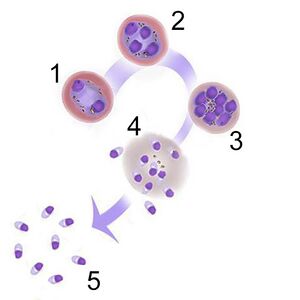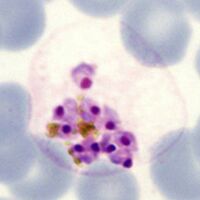Pre-erythrocytic (liver) stage
From haematologyetc.co.uk
Navigation
(click blue highlighted text to return to page)
Malaria main index
>Basic malaria biology
>>This page: Pre-erythrocytic (liver) stage
| The schizont pathway |
The stage begins with the first cycle of asexual replication forming a recognisable “schizont” then concludes when the individual “merozoites” are released to infect new erythrocytes.
| Merozoite release |
(1) The stage begins with the first cycle of asexual division producing two chromatin masses
(2) This is followed by further cycles of replication
(3) In this case this results in the formation of 8 daughter parasites
(4) The daughter parasites mature and the red cell ruptures to release the “merozoites”
(5) The released merozoites very rapidly infect new red cells (so rapid that free merozoites will not usually be seen in blood).
| Morphological features and relevance |
(1) The number of replication cycles differs between species: the typical number of merozoites formed differs between species with as few as 8 (in P.malariae) up to a possible 32 (in P.vivax)
(2) This stage may not always occur in blood: schizonts of P.falciparum adhere within the small vessels so is not seen in blood unless infection is very severe
→ Click for more images of schizont morphology
| Relevance of schizonts to clinical biology |
The release of merozoites from schizonts exposes the body to large amounts of free parasite antigens no longer contained within the erythrocytes - the result is an immune response causing high fever and illness symptoms. In some cases the development of parasites is synchronous so that all schizonts mature and release their merozoites at the same time - although rarely seen now, this pattern of development may produce a pattern of remitting fever with a distinct periodicity depending on species: underlying the older descriptive terms tertian or quartan malaria.


